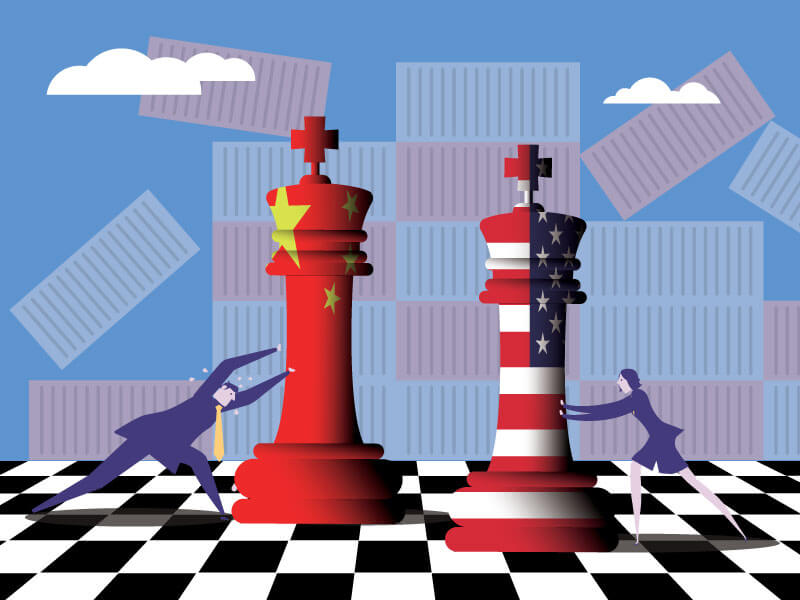
Clue in on what importers need to know now, what’s going on with rate changes authorized under the IEEPA, and if there’s an occasion when importers can avoid Section 301 tariffs altogether.
Remember to come back here for quick and easy updates as US and Chinese trade negotiations continue. I’ll keep you posted, so bookmark this article in your browser now.
As always, should you need additional guidance from a trusted professional, give us a call at (855) 912-0406. For now, let’s get this tariff talk tackled.
The Section 301 review conducted in 2024 by the USTR (Office of the U.S. Trade Representative), announced in December several tariff increases that started January 1, 2025.
While the semiconductor increase were planned, tungsten products, wafers, and polysilicon were also added.
On the topic of exclusion expirations, let me refresh your memory: 164 exclusions were granted in 2022 and later extended to expire May 31, 2025. They were extended again through August 31.
New tariffs, modified duties, and exclusion updates are enough to make any importer want to tear their own hair out.
But, you don’t have to…just contact our professional customs clearance experts online for help.

The new year brings with it a new (or returning) administration with the re-election of President Donald Trump. While there are no rapid changes to Section 301 tariffs themselves, other actions by the new President are still increasing various import costs, some of which have been authorized via the International Emergency Economic Powers Act. Rates can fluctuate due to exceptions, sectoral changes, and trade policy adjustments for economic considerations.
On February 1, 2025, President Trump signed an executive order imposing an additional 10% ad valorem duty on imports from China. These tariffs were in addition to the duties owed per Section 301.
No specific HTS list was provided, which required importers to assume that all entries intended for consumption in the US were required to pay the additional duty. Unlike current Section 301 policies, these payments will not be eligible for duty-drawback.
Entries under Section 321, which qualify for duty-free status under the $800 threshold granted by de minimis were suspended as well. Because such shipments have become a major source of imports in the last two years, parcel handlers found themselves overwhelmed with how to collect all the duties.
The lift on de minimis exemptions is expected to be temporary until uniform collection methods are in place. No specific timeline was provided.
In response to this unilateral application of tariffs, China announced counter tariff measures that took effect Monday, February 10. They targeted specific American products, applying tariffs between 10% to 25% ad valorem. The following products were impacted:
Further negotiations between China and the US may mitigate some or all of the responses, as they did in a similar situation when tariffs were imposed on Mexico and Canada. In the meantime, plan your import budget taking the tariff hikes into account.
Should you want to learn more about How Trump's Trade Policies May Impact International Trade, read all about it.

On March 4, 2025, the 10% ad valorem duty initially levied against products from China was raised to 20%, impacting all current products. Other measures initially introduced by the executive order from February also remained in effect.
As before, the 20% duty that importers are responsible for upon entry is additional to current Section 301 duties that remained in place.
Why were tariffs raised again? The Trump administration was dissatisfied with China’s efforts to mitigate the entry of various illegal substances into the US, including fentanyl. This was one of the original reasons the tariffs were issued in the first place.
In April, a White House announcement solidified the plan to issue reciprocal tariffs impacting various nations, including China. After weeks of increasingly high retaliatory orders from both nations, an agreement was finally reached on May 12th, as each country made certain concessions.
The agreement further clarified how commercial tariffs will be adjusted, as well as how fees on low-value personal shipments were to be changed.
If you’re a personal importer seeking information on low-value shipments, visit our article Section 321 Shipments: De Minimus and Duty-Free Imports.
On May 15, 2025, CBP published tariff refund procedures and HTSUS modifications to implement Executive Order 14289: Addressing Certain Tariffs on Imported Articles. They include covered goods entered for consumption, or withdrawn from warehouse for consumption.
According to CBP, the order eliminates the stacking of sectoral, reciprocal, and trade act-derived tariffs.
“This order shall apply retroactively to all entries of merchandise subject to any applicable tariffs outlined in section 2 of this order and made on or after March 4, 2025. Any refunds will be processed pursuant to applicable laws and U.S. Customs and Border Protection's standard procedures for such refunds.”
Importers may request refunds with CBP directly by filing post summary corrections or protests (as applicable).
You may have heard that in late June 2025, President Trump terminated trade discussions with Canada as a response to their decision to proceed with a 3% digital services tax (DST) on technology companies. While a new Canada-specific tariff rate was to be announced by the US within seven days of this action, an official one has yet to be provided.
As of July 7, the President extended the temporary lower rate that was originally set to expire July 8, per Executive Order 14266 (originally issued in April 2025). This means US applicable trading partners will continue to face a lower, 10% import tariff, instead of the higher rates originally imposed earlier this year. The new expiration date is August 1st.
However, China is still excluded from this reciprocal tariff rate extension. Chinese imports are still being treated under a different policy from a separate executive order (Executive Order 14298), which remains intact and unchanged.
Let’s break down the current US’ country-specific rates on imports from China:
However, there’s also a 90-day pause that began May 14 to further lower the ad valorem rate to 10%. Effective August 12, the duty rate will fall back to 34% unless the administration introduces a new agreement or extension. If you need more information on how this affects your Chinese import tariffs, call our team at (855) 912-0406.
The short answer, is yes and no. Here’s why…as discussed earlier, 164 exclusions were extended, new ones were added, and others are being considered.
There’s hope around every corner.
As of May 2, 2025 products from China will no longer be allowed to use the de minimis provision to bypass Section 301 tariffs. The executive order signed by President Trump on February 1, 2025 suspended its use indefinitely, or until said order is removed.
A surcharge on low-value shipments is now in place. The charge depends on whether the import is entering as commercial freight or through international postal services.
For the details on the surcharge, visit Section 321 Shipments: De Minimis and Duty-Free Imports.
Now, should the order be removed in the future, be aware that the rules previously surrounding Section 301 shipments are likely to change. So it’s important that you stay tuned here for continuous updates and how they may impact your business.
Per CBP, Section 301 tariffs are based on country of origin, not export location.
"At this time, the additional duties imposed by the Section 301 remedy only apply to articles that are products of the People’s Republic of China (ISO Country Code CN). Imported goods that are legitimately the product of Hong Kong (HK) or Macau (MO) are not subject to the additional Section 301 duties."
Who’s winning in this supply chain standoff? You could be if you make sure you’re:

Circumvent customs and import issues by quickly contacting the pros online.
For more about how we can help your business thrive, check out these additional services:
Don’t worry, we’re not allergic to the phone. You can also call us at (855) 912-0406 to tap into expert help for your exclusive needs. You’re just one click away!
 Copy URL to Clipboard
Copy URL to Clipboard
Add your first comment to this post